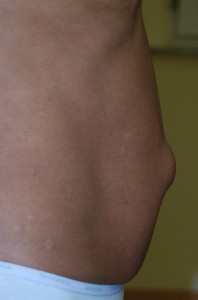Epigastric hernia

Hernias, which are formed in the presence of a break in the upper midline of the abdominal wall muscles in the epigastric region. It can be composed of multiple hernias. It can also be larger than an egg and contains mostly abdominal fat, rarely intestinal loops. Small hernias may be asymptomatic.
therapy
The treatment is surgical. In the case of small hernias primary closure is the most practiced. Rather different is the case of larger hernias which, if treated with direct suture may often recur. In these cases it is preferable the placement of a prosthesis between the peritoneum and the posterior abdominal wall, thus respecting the kinetics of the abdominal wall with fixation free technique.
the freedom octomesh implant xs
The Octomesh implant XS, developed by Prof. Amato and a team of physiologists and engineers, eliminates the need for fixation (with sutures or similar). Ensures a very broad coverage of the defect, requires smaller incisions, diminishes the surgical trauma. All in all, it results in a faster and easier procedure. The complication rate is very low and no recurrences are reported in a follow up of 3 years.
the technique developed by prof. amato for epigastric hernia: how it works
The “tentacles” of the Octomesh implant are the key element that allows a huge step forward in terms of safety in surgical operations and clinical results.
Once positioned the mesh, the “tentacles” are tunneled with a special instrument through the fat tissue under the skin, thus ensuring the mesh an adequate holding force (friction) to keep the implant in place without sutures. In this way, the mesh is perfectly anchored by 8 “tentacles”. While at same day of the procedure, to dislodge one strap 280 gram pull out force is needed, 15 days later a traction force greater than 40 kg is needed to remove all the straps.
This type of fixation with friction but without sutures (Prof. Amato uses the neologism of “Freexation” to define this concept) is successfully used since nearly 10 years in procedures for urinary stress incontinence in women, with millions of operations performed today. (1, 2, 3, 4, 5)
advantages for the patient
The advantages for the patient are:
- Small incision, less surgical trauma and better cosmetic results
- Broad coverage of the defect with consequent reduction of the possibility of recurrence
- Shorter operative procedure
- Low complications rate
- No recurrence, in a follow-up of 3 years
advantages for the surgeon
The advantages for the surgeon are:
- Fixation free procedure
- Easier procedure
- Faster procedure
- Broader coverage of the defect
- Standardized procedure, easy reproducibility (learning curve ca. 5 interventions)
- Reduction of complications compared to conventional implants and no recurrences in a follow-up of 3 years
references
- Amato G. et al. The use of a tailored mesh with special design for ventral hernia repair. A preliminary report. Hernia (2009);13:S1 73-10
- Amato G. et al. Prosthetic strap system for simplified ventral hernia repair: results of a porcine experimental model Hernia 2010; 14:389-395
- Amato G. et al. A new shape of the mesh to simplify and standardize the implantation in ventral hernia repair procedures. Hernia 2010; 14: S-43
- Amato G. et al. A new and improved shape of mesh implantation procedures to simplify and standardize open ventral hernia repair. A preliminary report. Hernia DOI: 10.1007/s10029-011-0842-9